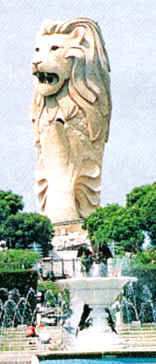|
|
Singapore is located 137 km North of the equator, between longitudes 103, 36' East and 104,25' East; 42 km in length; 23 km in breadth; 645 sq. km in area and approximately 150.5 km of coastline.
Singapore was first mentioned in 1365 AD in Javapese "Nagarakretagama' as "Temasek" or Sea Town. A third-century Chinese account described Singapore a "Pu-lou-chung" or island at the tip of a peninsula. But it was from 14th century, following a Sumatran prince mistaking a tiger from a lion, that Sanskrit term "Singapura" or Lion City gained currency.
It was Sir Stamford Raffles, a 19th century British civil servant, who founded Singapore in 1819. An official of British East India Company, Raffles combed Straits of Malacca for a small trading station, to counter Dutch influence in area. The tiny fishing village of Singapore was perfect, because it was at the crossroads of East and West.
Raffles did not just discover Singapore. He literally laid the city's foundations. After establishing a trading post, he planned to build a business quarter on one side of Singapore River. But, because it was low-lying, he ordered a small hill to be excavated to fill up the area. Today, that land is the core of the city and the heart of Shenton Way, Singapore's answer to Wall Street.
After Raffles, the next man credited with the rise of modern Singapore, is Lee Kuan Yew. His potent formula for nation-building, since Singapore's independence in 1965, has been initiated, but hardly paralleled in any part of the world. Mr. Lee is presently Senior Minister in the government.
Economists describe Singapore as a "modern miracle", because it has built its success on only one resource, its people, and without natural resources.
Singapore retains its special multiracial quality acquired from its early days, when Arabs, Chinese, Europeans, Indians and Strait-born Chinese (or Peranakan) came to live side by side with indigenous Malays.

Majestic Merlion Tower
|
|

